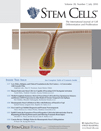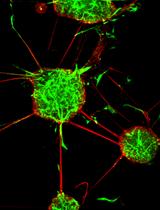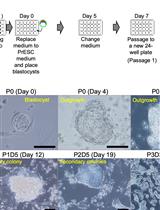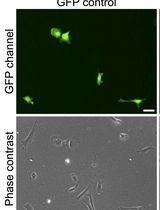- EN - English
- CN - 中文
Transfection of Embryoid Bodies with miRNA Precursors to Induce Cardiac Differentiation
用miRNA前体转染拟胚体来诱导心肌分化
发布: 2016年02月05日第6卷第3期 DOI: 10.21769/BioProtoc.1726 浏览次数: 9424
评审: Jingli CaoAnonymous reviewer(s)
Abstract
In recent years, the utilization of stem cell therapy to regenerate cardiac tissue has been proposed as a possible strategy to treat cardiac damage (Gnecchi et al., 2012, Aguirre et al., 2013; Sanganalmath and Bolli, 2013). Although encouraging results have been obtained in experimental models, the efficiency of cardiac regeneration is very poor and one of the major barriers to progress in the area of cell therapy for damaged heart is represented by the limited capacity of cells to differentiate into mature cardiomyocytes (CMC) (Laflamme and Murry, 2011). Cell manipulation and transfection represent versatile tools in this context (Melo et al., 2005; Dzau et al., 2005). Murine P19 embryonal carcinoma cells are a well-established cell line capable of differentiating in vitro into spontaneously beating CMC. This cell system with its limited cell culture requirements, protocol reproducibility and ease in uptake and subsequent expression of ectopic genetic materials render it ideal for the study of the cardiac differentiation process. P19 cells have been successfully used to gain important insights into the early molecular processes of CMC differentiation (van der Heyden and Defize, 2003; van der Heyden et al., 2003). P19 cells can also be maintained in an undifferentiated state in a monolayer culture when grown in adherence; this condition allows the enrichment of large cell numbers useful for cardiac differentiation protocols (McBurney, 1993). On the other hand, when cultured in bacterial dishes, P19 cells will grow in suspension and generate embryoid bodies (EB). When exposed to dimethyl sulfoxide (DMSO), EB differentiate into spontaneously beating cells, which can be defined as CMC. This definition is based on their gene and protein expression and their electrophysiological properties (Wobus et al., 1994; van der Heyden et al., 2003). In our laboratory, we used this in vitro model to verify whether the over-expression of a defined combination of miRNA can synergistically induce effective cardiac differentiation (Pisano et al., 2015). We used miRNA1, miRNA133 and miRNA499 alone or in combination. Here, we describe how we transiently transfect P19 cells to over-express a single or a combination of miRNA precursors (pre-miRNA).
Keywords: MicroRNA (microRNA)Materials and Reagents
- Bacterial dishes (100 x 15 mm) (Corning, catalog number: 351006 )
- Standard culture Petri dishes (100 x 15 mm) (Corning, catalog number: 70165-101 )
- 6 multiwell-plates (Corning, catalog number: 353224 )
- 50 ml tubes (Falcon®, catalog number: 352098 )
- P19 cells (Izsler-Istituto Zooprofilattico Sperimentale, Lombardy and Emilia Romagna “Bruno Ubertini”, Brescia, Italy) (Izsler, catalog number: BS-TCL 206 , Passage 0)
- Minimum Essential Medium alpha (α-MEM) (Sigma-Aldrich, catalog number: M8042 )
- Penicillin-streptomycin 10,000 U/ml (Thermo Fisher Scientific, GibcoTM, catalog number: 15140-122 )
- L-glutamine 2 nM (Thermo Fisher Scientific, GibcoTM, catalog number: 25030-081 )
- Dimethyl sulfoxide (Sigma-Aldrich, catalog number: D4540-100 ml )
- Fetal Bovine Serum (FBS) (Sigma-Aldrich, catalog number: F6178-50 ml )
- Trypsin-EDTA (0.5%), no phenol red (Thermo Fisher Scientific, GibcoTM, catalog number: 15400-054 )
- Optimem® (Thermo Fisher Scientific, GibcoTM, catalog number: 31985-070 )
- siPORT® NeoFX transfection agent (Thermo Fisher Scientific, Invitrogen™, catalog number: AM4511 )
- Pre-miRNA 1 (ID: 000385) (Thermo Fisher Scientific, Applied Biosystems®, catalog number: AM17100 ), Pre-miRNA 133 (ID: 000458) (Thermo Fisher Scientific, Applied Biosystems®, catalog number: AM17100), Pre-miRNA 499 (ID: 001045) (Thermo Fisher Scientific, Applied Biosystems®, catalog number: AM17100) molecules and scramble miRNA (negative control) (Thermo Fisher Scientific, Ambion™, catalog number: AM17110 )
- Culture medium (see Recipes)
- Standard differentiation medium (see Recipes)
- Mix A (see Recipes)
- Mix B (see Recipes)
Equipment
- Pipetus® Pipettes
- Laminar flow-hood (EuroClone S.p.A., model: S@feflow 1.8 )
- Humidified cell culture incubator set at 37 °C, 5% CO2 (Panasonic Corporation, Sanyo, model: MCO-18AC )
- Inverted bright light microscope equipped with a phase-contrast filter (ZEISS, model: Observer Z1 )
Procedure
文章信息
版权信息
© 2016 The Authors; exclusive licensee Bio-protocol LLC.
如何引用
Pisano, F. and Gnecchi, M. (2016). Transfection of Embryoid Bodies with miRNA Precursors to Induce Cardiac Differentiation. Bio-protocol 6(3): e1726. DOI: 10.21769/BioProtoc.1726.
分类
干细胞 > 胚胎干细胞 > 维持和分化
您对这篇实验方法有问题吗?
在此处发布您的问题,我们将邀请本文作者来回答。同时,我们会将您的问题发布到Bio-protocol Exchange,以便寻求社区成员的帮助。
Share
Bluesky
X
Copy link













